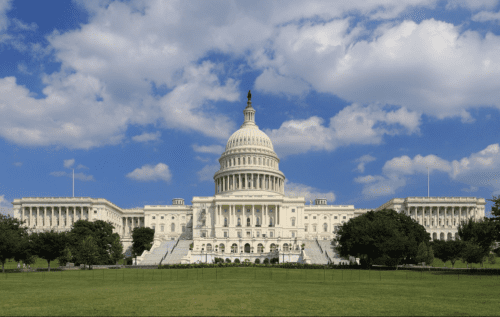
The state of national climate and energy policy
Will the Biden administration be able to meet its ambitious clean energy goals?
The 2020 election has led to sweeping changes in federal energy policy. President Biden has set ambitious goals to decarbonize the electricity sector, raise fuel economy standards, reduce greenhouse gas emissions, and make the entire economy carbon neutral. The House and Senate have passed and are now reconciling their versions of the $1 trillion bipartisan infrastructure bill, which includes substantial spending on electric vehicle (EV) infrastructure, the resilience and security of the power grid, new technologies, energy efficiency, and worker training programs. The $3.5 trillion “budget blueprint,” which narrowly passed in both houses along party lines, calls for investing hundreds of billions in climate and clean energy initiatives.
What does this all add up to? This blog post provides an overview of the current state of national clean energy and climate policy.
Executive Order: Protecting Public Health and the Environment and Restoring Science to Tackle the Climate Crisis
On his first day in office, President Biden issued a comprehensive executive order directing all executive departments and agencies to immediately begin the process of reversing the actions of the Trump administration that conflict with its stated objectives, which include listening to science, reducing greenhouse gas (GHG) emissions, and bolstering resilience. The order also directs work to commence to confront the climate crisis.
The order focuses on these actions, among others:
- Reducing methane emissions in the oil and gas sector
- Establishing ambitious fuel economy standards
- Upgrading appliance- and building-efficiency standards
- Protecting our air from harmful pollution
- Accounting for the benefits of reducing climate pollution
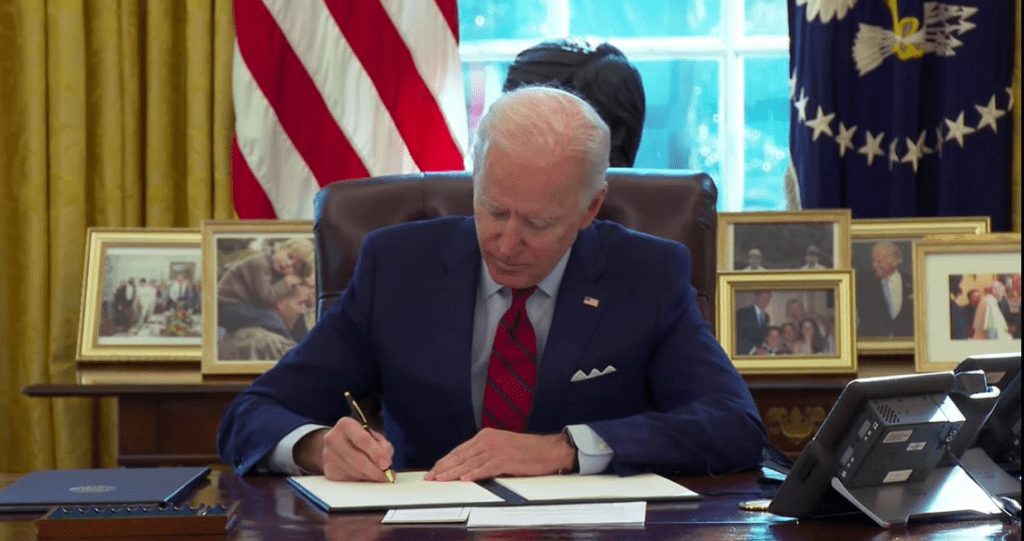
Executive Order: Tackling the Climate Crisis at Home and Abroad
A week after the inauguration, Biden followed up with another sweeping executive order on climate policy. This order establishes the National Climate Task Force to “facilitate theorganization and deployment of a Government-wide approach tocombat the climate crisis.” It also creates the White House Office of Domestic Climate Policy and calls for managing federal procurement and real property, public lands and waters, and financial programs to support robust climate action.
Some specific goals of the executive order include:
- Achieving or facilitating a carbon-free electricity sector no later than 2035, as well as clean and zero-emission vehicles for federal, state, local, and tribal government fleets.
- Increasing renewable energy production onfederal lands and waters, with the goal of doubling offshore wind by 2030 while ensuring robust protection for our lands, waters, and biodiversity and creating good jobs.
- Pausing new oil and natural gas leases on public lands or in offshore waters pending a comprehensive review.
- Eliminating federal fossil fuel subsidies.
- Ensuring that federal infrastructure investment reduces climate pollution.
- Revitalizing the economies of coal, oil and gas, andpower plant communities in the transition to cleaner energy.
Decarbonization commitments to the international community
In February 2021 the United States formally rejoined the Paris Agreement on climate change. Under the Paris Agreement, each member country publicly commits to specific reductions in its carbon emissions.
On Earth Day, 22 April 2021, the White House announced new targets for the US to achieve the goal of limiting global warming to 1.5° C. These ambitious commitments (and others made later) include:
- By 2030, achieve a 50% – 52% reduction from 2005 levels in economy-wide net GHG emissions.
- By 2030, achieve a 30% reduction in global methane emissions.
- By 2035, transition the electric power grid to be 100% carbon-free nationwide.
- By 2050, achieve net zero GHG emissions across the US economy.
- Provide $11.4 billion per year in climate financing to developing countries.

Transportation: Fuel economy/emissions standards
The transportation sector is the source of 29% of US carbon emissions, compared to 25% for the electricity sector.
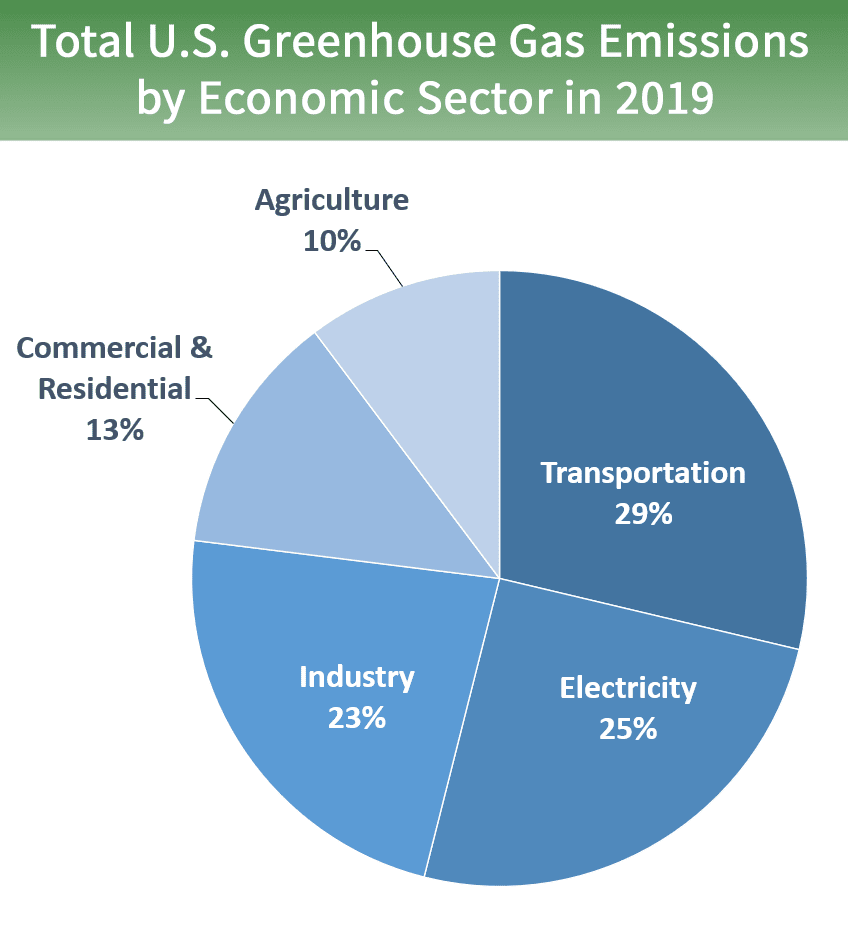
Recognizing this, under the Obama administration the Department of Transportation (DOT) and the Environmental Protection Agency (EPA) issued stringent standards for fuel economy and tailpipe emissions. These standards were relaxed under the previous administration, but under President Biden the EPA and DOT have proposed an aggressive schedule to increase mileage and reduce emissions, starting in 2024. Standards would be much stricter, increasing by 8% per year in model years 2024, 2025, and 2026. The preferred alternative proposed would require manufacturers to achieve these average fuel efficiencies across their passenger car fleets, with proposed standards for pickup trucks increasing by similar margins:

The White House also announced the goal for 50% of all new vehicles sold in 2030 to be zero-emissions, including battery electric, plug-in hybrid electric, and fuel cell electric vehicles.
Under the EPA’s Clean Trucks Plan for heavy-duty trucks and buses, by December 2022, the agency will propose and finalize stringent new emissions standards to reduce nitrogen oxides (NOx) pollution from trucks and buses starting in model year 2027. This action will include an update of current GHG standards to capture market shifts to zero-emission technologies in certain segments of the heavy-duty vehicle sector. The EPA is also working on new stringent GHG emissions standards for heavy-duty engines and vehicles starting as soon as model year 2030.
Infrastructure Investment and Jobs Act
The Senate passed the $1 trillion bipartisan infrastructure bill (H.R. 3684) on 10 August 2021. House Speaker Nancy Pelosi has pledged that the House will vote on the legislation by 27 September 2021, but she is facing resistance from within the Democratic caucus. Progressive members are insisting that the $3.5 trillion budget reconciliation bill be voted on together with the infrastructure bill.
The energy- and climate-related measures in the Senate version of the infrastructure bill include the following. (See more details here.)
Transportation
- The $13.2 billion Congestion Mitigation and Air Quality Improvement Program adds eligibility for zero-emission vehicles and charging equipment.
- The $6.42 billion Formula Carbon Reduction Program establishes a new program to reduce transportation emissions.
- The National Motor Vehicle Per-Mile User Fee Pilot would establish a pilot program to demonstrate a national motor vehicle per-mile user fee.
- Over $35 billion is allotted to railway investments.
- The legislation includes various EV charging infrastructure (EVCI) provisions, such as these:
- Biden has committed to deploying a national network of 500,000 charging stations. The legislation invests $7.5 billion to initiate the buildout of this network and provides funding for deployment of EV chargers along highway corridors and within communities.
- The Charging and Refueling Grant Program authorizes $2.5 billion over five years for Alternative Fuel Corridors, with 50% of the total funds available for Community Grants to install EVCI on roads, schools, parks, and in public parking facilities, prioritized for rural and low- and moderate-income communities.
- The bill appropriates $1 billion per year for five years to establish an EV Charging Formula Program at the DOT to provide funding to states for EVCI.
- The Clean School Bus Program appropriates $1 billion per year for five years to implement a school bus change-out program at the DOE.
- The Electric or Low-Emitting Ferry Pilot Program appropriates $250 million for a new low-emission ferries and rural ferry systems grant program.
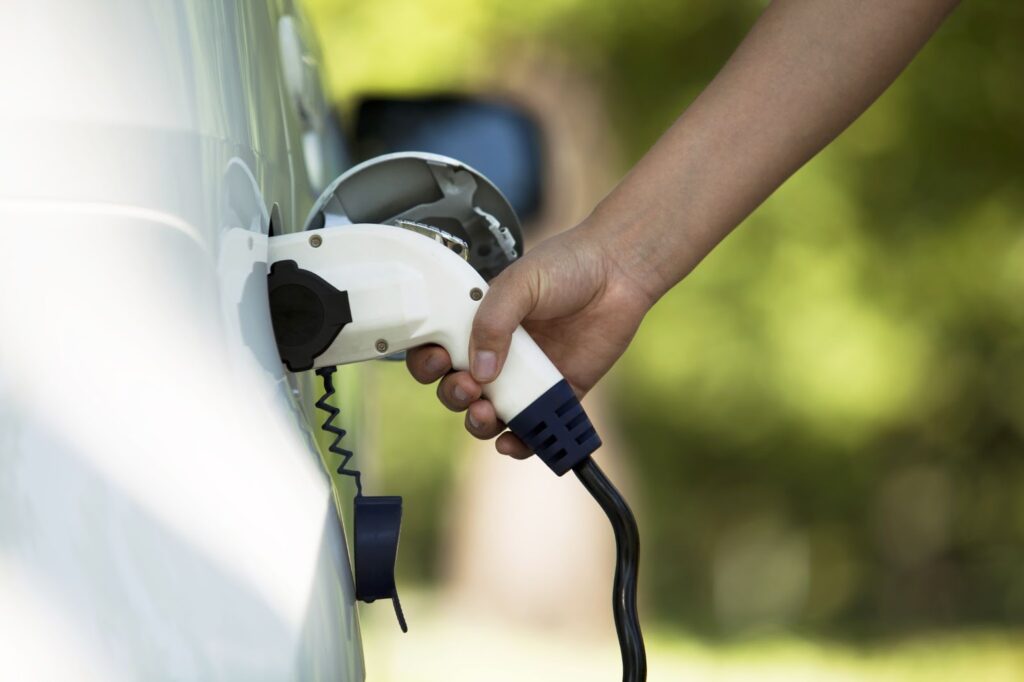
Energy and grid infrastructure, resilience
- The legislation includes the Energy Infrastructure Act (S. 2377), authorizing funding and programs for an array of fuel sources and technologies, including the reliability and resilience of the electric grid.
- The legislation appropriates approximately $65 billion to harden and enhance the nation’s electric grid infrastructure. Provisions include:
- $5 billion in grants to states and tribes, grid operators, fuel suppliers, and others to supplement efforts to harden the electric grid against disruptive extreme weather events.
- $2.5 billion for a revolving loan fund to facilitate the construction of new or replacement energy transmission lines.
- $3 billion for the Smart Grid Investment Matching Grant Program, adding eligibility for technologies for increased flexibility in responding to natural disasters, fluctuating demand, and other events necessitating a quick rebalance of the grid.
- $500 million for State Energy Conservation Plans that support transmission and distribution planning.
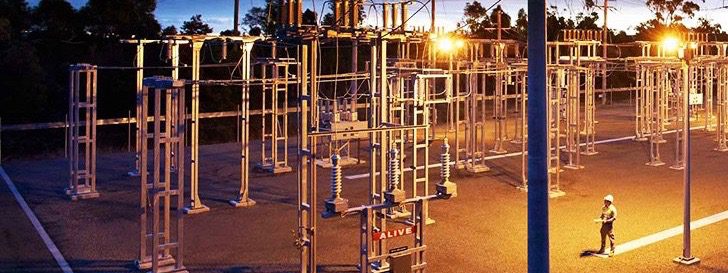
Energy efficiency and building infrastructure
- The bill authorizes numerous programs to encourage and fund energy efficiency upgrades for various types of buildings.
- Allocations include:
- $250 million to establish the Energy Efficiency Revolving Loan Fund Capitalization Grant program under the State Energy Program for states to conduct energy audits or upgrades and retrofits of residential and commercial buildings.
- $40 million to states to train individuals to conduct energy audits.
- $225 million toward a competitive grants program through DOE’s Building Technologies Office for states or regional partnerships to implement updated building energy codes, including through training and data collection.
- $10 million in grants to institutions of higher education to establish training centers in energy-efficient design and operations, plus $10 million for nonprofit partnerships between public employers, industry, and labor for career skills training programs.
- $3.5 billion for the Weatherization Assistance Program (WAP), which reduces energy use by low-income households through installation of cost-effective energy savings upgrades and improvements.
Clean energy demonstration projects
The legislation establishes a new Office of Clean Energy Demonstrations (OCED) within DOE to oversee and manage demonstration projects funded by this bill as well as the Energy Act of 2020. Funded at $21.46 billion, the OCED would support efforts to commercialize clean energy technologies, reduce costs, and address barriers to widespread deployment.
Energy security
The bill promotes and incentivizes enhanced physical security and cybersecurity of the electric grid. It establishes voluntary programs, provide grants to utilities to respond to threats, and promote the use of advanced technologies.
Supply chains for clean energy technologies
The bill supports the supply chain for clean energy technologies, specifically for large-capacity batteries and critical materials. Provisions include battery manufacturing and recycling grants, funding for critical minerals mining and recycling research, and funding for a rare earth demonstration facility.
Fuels and technology infrastructure investments
The legislation supports the development of fuel and technology sources, including carbon capture, utilization, and storage (CCUS) and hydrogen.
Loan programs
The DOE Loan Programs Office (LPO) is charged with reducing GHG emissions through investment in U.S. projects. The legislation provides for improved energy infrastructure investment through federally backed debt capital.
Differences between the House and Senate programs
The House plan would require states to meet specific emissions goals by tracking current emissions and future reductions, while the Senate program would have no such requirement. Instead, the Senate plan would require states to develop a strategy to reduce emissions but would have no consequences if they do not. The House program would include regular reports on how states are performing and would require states to shift some of the other federal funds they receive to emissions reductions if progress is not sufficient.
Critiques of the infrastructure bill
Many House Democrats want more funding for EV and other climate measures than the Senate bill contains, at least the $174 billion that was initially proposed.
Several key elements of Biden’s energy and climate agenda were excluded from the infrastructure bill to win Republican support, notably:
- The Clean Electricity Standard would incentivize utilities to switch from fossil fuels to clean sources, with financial rewards for staying on schedule to achieve 100% renewable power by 2035, and penalties if they fall behind. This was deleted from the infrastructure bill but was added to the House version of the $3.5 trillion reconciliation bill.
- The investment and production tax credits that support solar, wind, and other renewable energy projects are currently set to decrease and then expire over the next several years. The infrastructure bill would not extend the tax credits, but the House version of the reconciliation bill would extend them for ten years – and would also add a special credit for projects in low-income communities, as well as making energy storage and transmission lines eligible for tax credits.
Many environmental groups have criticized the bipartisan infrastructure bill for allocating huge amounts to expand highways and related infrastructure, which will perpetuate high volumes of vehicle use and resulting GHG emissions.
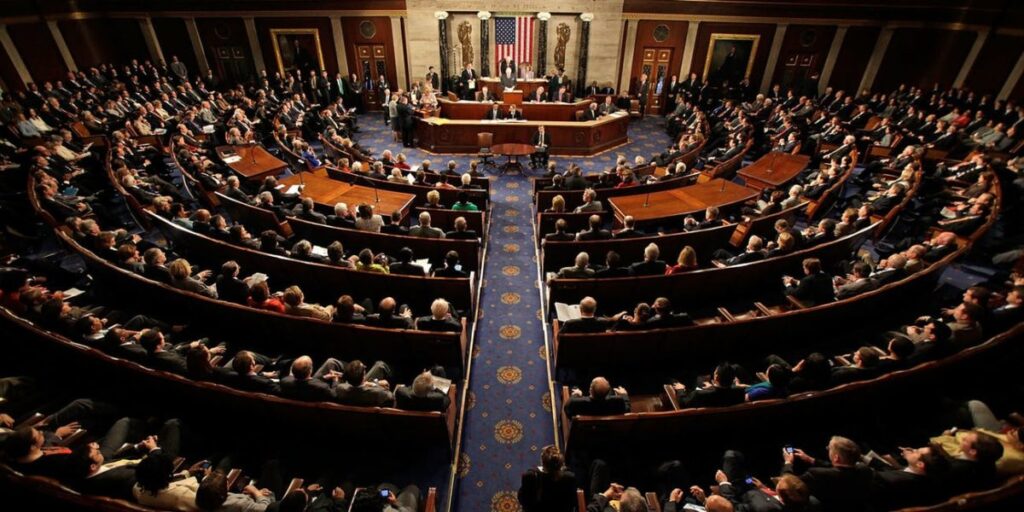
Budget reconciliation: What happens next
The $3.5 trillion Budget Blueprint passed the Senate on 11 August and the House on 24 August 24 2021, both along party lines. The FY 2022 budget reconciliation instructions are based on the framework agreement reached on 13 July 2021 in the Senate Budget Committee, with the support of Majority Leader Chuck Schumer and President Biden. The agreement calls for $3.5 trillion in investments to be offset by a combination of new tax revenues, health care savings, and long-term economic growth.
Democrats are using the reconciliation process because budget legislation requires only a simple majority vote, and they do not have the 60 votes needed to overcome a filibuster. It is far from clear, however, that even 50 senators would vote in favor of the current $3.5 trillion bill.
Senate leadership asserts that the Budget Resolution provides for “the most significant investment in tackling the climate crisis in US history, putting America on a path to meet President Biden’s climate change goals of 80% clean electricity and 50% economy-wide carbon emissions reductions by 2030.” The reconciliation package will likely represent his best chance to deliver on his climate agenda. The president, Pelosi, and Schumer have acknowledged that the bipartisan infrastructure bill falls short on climate initiatives and have committed to simultaneously advance bold investments through the reconciliation package.
As passed, the framework provides only general instructions on how the $3.5 trillion would be spent. The respective House and Senate Committees have been working to develop the specific policy proposals and precise funding levels that would be enacted in the budget reconciliation bill. The House Committees completed their markups in mid-September 2021, whereas the Senate Committees are still developing their final policy and spending proposals.

